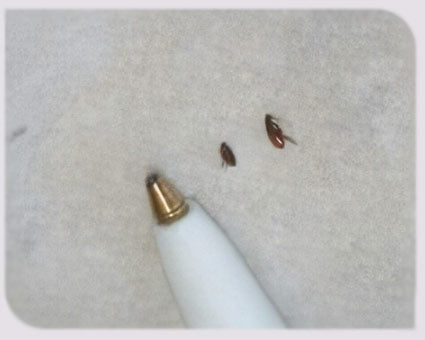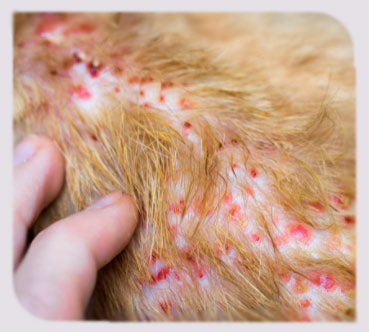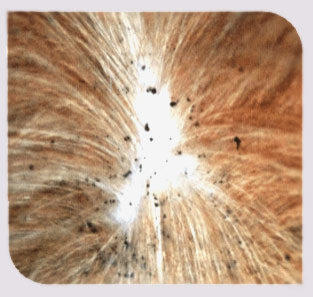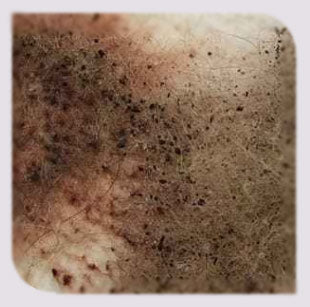Skip to content
Fleas

- Fleas are common in cats and dogs. They are tiny and brown and move very quickly!
- Fleas are very contagious, so can spread easily between dogs and cats and cause them to become very itchy.
- Some animals are allergic to the saliva in flea bites so can get very irritated skin where they bite, which goes on to become infected.
- Fleas feed on your pet's blood but can also transmit tapeworms and other infections to your pets.
- Fleas reproduce very quickly - 1 flea can become 1000 in just 3 weeks!
- Humans can't 'catch' fleas but they can still jump on you and bite, sometimes causing a nasty reaction, they just can't live on you!
- 95% of the lifecycle of the flea is in the environment. The adult fleas live on your pet and lay eggs, which then roll off into your home. The flea pupae can lie dormant for up to a year until passing animals trigger them to hatch. These pupae are responsible for keeping the flea life cycle going and can only be killed by fire!
 Actual size of fleas
Actual size of fleas
signs of a flea infection
- Itching particularly on their backs and tummies.
- Red and broken skin.
- Little black dots stuck near the base of their hairs (flea dirt).
- Dark coloured fast moving 1-4mm things seen moving in their coats
- Fleas move very quickly, so if you're worried your pet may have them but can't see any it is worth using a flea comb. This will not only help to comb out fleas but will also pick up flea dirt, which is flea poo! This maybe the only sign your animal has fleas.
- To use a flea comb gently run it through your pets coat in the direction their hair falls. It is important not to try and do this if you pet doesn't like being groomed/stroked or if they show signs of becoming stressed or upset when you try.
 Flea Allergic Dermatitis
Flea Allergic Dermatitis
 Flea dirt (actually digested blood the flea poops out!")
Flea dirt (actually digested blood the flea poops out!")
diagnosing flea infection
- Once you have run the comb through their coat a few times take what you've collected and place it on a piece of wet kitchen roll/toilet roll/cotton wool. It is important that what ever you use is white!
- Flea dirt is basically digested blood that the flea has sucked from your pet and pooped out! It looks like small dark specs but when you put it on wet roll you will see it turn back to blood. This will help you to diagnose fleas!
 Flea dirt wet paper test
Flea dirt wet paper test
Treating flea infections
Step 1: Treat your pets with an effective flea treatment
- Treat all animals in your household, not just the ones you've seen fleas on.
- You will need a different product for cats and dogs and will also need to know your pet's weight to get the right concentration.
- Please contact you vet for advice on the best products available as unfortunately fleas are starting to become resistant to a lot of products out there on general sale!
Step 2: Treat your home
- 95% of the lifecycle of the flea is in the environment (i.e. in carpets, floorboards and soft furnishings), so it is really important to treat your house with an effective household flea spray.
- Use a product that will stop the development of eggs and larvae and also stop kill any fleas hanging around! Always follow the instructions carefully as some products can be harmful to household plants and fish, for example.
- Speak to your vet for advice on suitable products. Indorex is a good one that is widely available.
- Vacuum daily for the next week to encourage fleas in pupae in your home to hatch and be killed (the vibrations from the vacuum can help to wake them up!)
- Remember to treat your entire home and all areas your pet may have been, e.g. the car, crates, pet carriers.
- Wash all of your pet's bedding thoroughly on a hot wash (at least 60°C).
Prevention
- Year round anti-flea treatment for all your pets. Speak to your vet for advice on the best product to use for your pet. Make sure that the correct dose is given for your pet's weight and applied correctly.
- Brush your pets regularly too to double check for pesky fleas!

 Actual size of fleas
Actual size of fleas
 Flea Allergic Dermatitis
Flea Allergic Dermatitis Flea dirt (actually digested blood the flea poops out!")
Flea dirt (actually digested blood the flea poops out!") Flea dirt wet paper test
Flea dirt wet paper test




